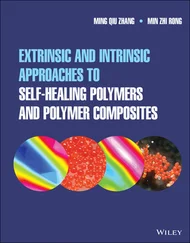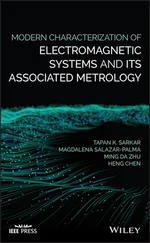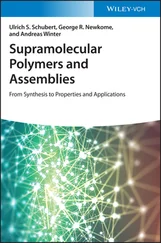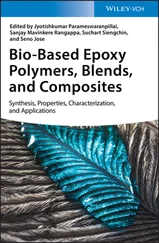Flexible Thermoelectric Polymers and Systems
Здесь есть возможность читать онлайн «Flexible Thermoelectric Polymers and Systems» — ознакомительный отрывок электронной книги совершенно бесплатно, а после прочтения отрывка купить полную версию. В некоторых случаях можно слушать аудио, скачать через торрент в формате fb2 и присутствует краткое содержание. Жанр: unrecognised, на английском языке. Описание произведения, (предисловие) а так же отзывы посетителей доступны на портале библиотеки ЛибКат.
- Название:Flexible Thermoelectric Polymers and Systems
- Автор:
- Жанр:
- Год:неизвестен
- ISBN:нет данных
- Рейтинг книги:3 / 5. Голосов: 1
-
Избранное:Добавить в избранное
- Отзывы:
-
Ваша оценка:
- 60
- 1
- 2
- 3
- 4
- 5
Flexible Thermoelectric Polymers and Systems: краткое содержание, описание и аннотация
Предлагаем к чтению аннотацию, описание, краткое содержание или предисловие (зависит от того, что написал сам автор книги «Flexible Thermoelectric Polymers and Systems»). Если вы не нашли необходимую информацию о книге — напишите в комментариях, мы постараемся отыскать её.
Comprehensive review of the rapidly evolving field of flexible thermoelectric polymers Flexible Thermoelectric Polymers and Systems
Flexible Thermoelectric Polymers and Systems
Flexible Thermoelectric Polymers and Systems — читать онлайн ознакомительный отрывок
Ниже представлен текст книги, разбитый по страницам. Система сохранения места последней прочитанной страницы, позволяет с удобством читать онлайн бесплатно книгу «Flexible Thermoelectric Polymers and Systems», без необходимости каждый раз заново искать на чём Вы остановились. Поставьте закладку, и сможете в любой момент перейти на страницу, на которой закончили чтение.
Интервал:
Закладка:
Library of Congress Cataloging‐in‐Publication Data
Names: Ouyang, Jianyong, author.
Title: Flexible thermoelectric polymers and systems / edited by Jianyong Ouyang, National University of Singapore.
Description: 1st edition. | Hoboken, NJ : Wiley, 2022. | Includes index.
Identifiers: LCCN 2021033949 (print) | LCCN 2021033950 (ebook) | ISBN 9781119550709 (hardback) | ISBN 9781119550723 (ebook) | ISBN 9781119550686 (epdf) | ISBN 9781119550631 (epub)
Subjects: LCSH: Thermoelectric apparatus and appliances–Materials. | Thermoresponsive polymers. | Flexible electronics.
Classification: LCC TK2950 .O987 2022 (print) | LCC TK2950 (ebook) | DDC 621.31/243–dc23
LC record available at https://lccn.loc.gov/2021033949LC ebook record available at https://lccn.loc.gov/2021033950
Cover Design: Wiley
Cover Image: © Ajwad Creative/Getty
List of Contributors
Shanshan ChenSchool of Energy & Power Engineering State Key Laboratory of Power Transmission Equipment & System Security and New Technology Chongqing University Chongqing P. R. China
Xinyi ChenKey Laboratory of Textile Science & Technology of Ministry of Education College of Textiles Donghua University Shanghai China
Hanlin ChengDepartment of Materials Science and Engineering National University of Singapore Singapore Singapore
Ming Hui ChuaInstitute of Materials Research and Engineering (IMRE) Agency for Science, Research and Technology (A*STAR) Singapore Singapore
Minzhi DuKey Laboratory of Textile Science & Technology of Ministry of Education College of Textiles Donghua University Shanghai China
Zeng FanSchool of Physics Dalian University of Technology Dalian P. R. China
Xue HanKey Laboratory of Textile Science & Technology of Ministry of Education College of Textiles Donghua University Shanghai China
Lin HuChina‐Australia Institute for Advanced Materials and Manufacturing Jiaxing University Jiaxing P. R. China
Fengxing JiangFlexible Electronics Innovation Institute Jiangxi Science and Technology Normal University Nanchang P. R. China Department of Physics Jiangxi Science and Technology Normal University Nanchang P. R. China
Yuanyuan JingKey Laboratory of Textile Science & Technology of Ministry of Education College of Textiles Donghua University Shanghai China
Meng LiMOE Key Laboratory of Low‐grade Energy Utilization Technologies and Systems CQU‐NUS Renewable Energy Materials & Devices Joint Laboratory School of Energy & Power Engineering Chongqing University Chongqing P. R. China
Zaifang LiChina‐Australia Institute for Advanced Materials and Manufacturing Jiaxing University Jiaxing P. R. China
Peipei LiuDepartment of Physics Jiangxi Science and Technology Normal University Nanchang P. R. China
Congcong LiuFlexible Electronics Innovation Institute Jiangxi Science and Technology Normal University Nanchang P. R. China
Yang LiuMOE Key Laboratory of Low‐grade Energy Utilization Technologies and Systems CQU‐NUS Renewable Energy Materials & Devices Joint Laboratory School of Energy & Power Engineering Chongqing University Chongqing P. R. China
Baoyang LuFlexible Electronics Innovation Institute Jiangxi Science and Technology Normal University Nanchang P. R. China
Chunhong LuKey Laboratory of Textile Science & Technology of Ministry of Education College of Textiles Donghua University Shanghai China
Jianyong OuyangDepartment of Materials Science and Engineering National University of Singapore Singapore Singapore
Lujun PanSchool of Physics Dalian University of Technology Dalian P. R. China
Yue ShuMOE Key Laboratory of Low‐grade Energy Utilization Technologies and Systems CQU‐NUS Renewable Energy Materials & Devices Joint Laboratory School of Energy & Power Engineering Chongqing University Chongqing P. R. China
Kuan SunMOE Key Laboratory of Low‐grade Energy Utilization Technologies and Systems CQU‐NUS Renewable Energy Materials & Devices Joint Laboratory School of Energy & Power Engineering Chongqing University Chongqing P. R. China
Ady SuwardiInstitute of Materials Research and Engineering (IMRE) Agency for Science, Research and Technology (A*STAR) Singapore Singapore
Zhenghong XiongMOE Key Laboratory of Low‐grade Energy Utilization Technologies and Systems CQU‐NUS Renewable Energy Materials & Devices Joint Laboratory School of Energy & Power Engineering Chongqing University Chongqing P. R. China
Jianwei XuInstitute of Materials Research and Engineering (IMRE) Agency for Science, Research and Technology (A*STAR) Singapore Singapore
Jingkun XuFlexible Electronics Innovation Institute Jiangxi Science and Technology Normal University Nanchang P. R. China
Yuanyuan ZhengKey Laboratory of Textile Science & Technology of Ministry of Education College of Textiles, Donghua University Shanghai China
Yujie ZhengSchool of Energy & Power Engineering State Key Laboratory of Power Transmission Equipment & System Security and New Technology Chongqing University Chongqing P. R. China
Fengling ZhangDepartment of Physics Chemistry and Biology Linköping University Linköping, Sweden
Kun ZhangKey Laboratory of Textile Science & Technology of Ministry of Education College of Textiles Donghua University Shanghai China
Yinhua ZhouWuhan National Laboratory for Optoelectronics, and School of Optical and Electronic Information Huazhong University of Science and Technology Wuhan Hubei China
Yongli ZhouMOE Key Laboratory of Low‐grade Energy Utilization Technologies and Systems CQU‐NUS Renewable Energy Materials & Devices Joint Laboratory School of Energy & Power Engineering Chongqing University Chongqing P. R. China
Preface
Thermoelectric materials are interesting because they can be used to directly convert heat into electricity. Some conductive materials can exhibit a notable voltage under temperature gradient, that is, the Seebeck effect. The thermovoltage with respect to the temperature is called Seebeck voltage. The Seebeck voltage can be positive or negative depending on the accumulation of the charge carrier(s) at the two ends under temperature gradient. A p ‐type thermoelectric material exhibits a positive Seebeck voltage, while an n ‐type thermoelectric material has a negative Seebeck voltage. High Seebeck coefficient has been observed on semiconductors and semimetals. The value is related to the relative position of the Fermi level from the top of the valence band or the bottom of the conduction band or simply the doping level since a change in the doping level can shift the Fermi level. Apart from the Seebeck coefficient, a high electrical conductivity is also required for efficient thermoelectric conversion. However, a good thermoelectric material should have a low thermal conductivity so that more heat can be utilized for power generation. Thermoelectric materials are used as the active materials of thermoelectric generators. They can be used in thermoelectric cooling systems in terms of the Peltier effect as well.
The conventional thermoelectric materials are inorganic semiconductors or semimetals such as Bi 2Te 3and its derivatives or analogues. These materials can exhibit high Seebeck coefficient and high electrical conductivity, but they also have a problem of high thermal conductivity. Hence, great effort has been made on lowering the thermal conductivity of inorganic thermoelectric materials besides on the improvement in the Seebeck coefficient and/or electrical conductivity. Consider for practical application, inorganic thermoelectric materials are usually brittle, and thus they are not suitable for flexible thermoelectric systems.
Читать дальшеИнтервал:
Закладка:
Похожие книги на «Flexible Thermoelectric Polymers and Systems»
Представляем Вашему вниманию похожие книги на «Flexible Thermoelectric Polymers and Systems» списком для выбора. Мы отобрали схожую по названию и смыслу литературу в надежде предоставить читателям больше вариантов отыскать новые, интересные, ещё непрочитанные произведения.
Обсуждение, отзывы о книге «Flexible Thermoelectric Polymers and Systems» и просто собственные мнения читателей. Оставьте ваши комментарии, напишите, что Вы думаете о произведении, его смысле или главных героях. Укажите что конкретно понравилось, а что нет, и почему Вы так считаете.












